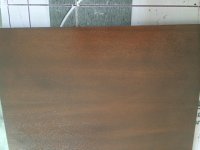I used my RO 125 to finish sand a bar top made of oak. The oak was originally milled as tongue and groove flooring. After sanding through 80, 100 and 120 grit in the fine sanding mode, I felt I was done. I began to apply a 1 lb cut of tinted shellac which immediately soaked into the oak and broadcasted lots of blotchy irregularities. Some of the blotchiness ran 45 to 90 degrees against the flow of the wood grain lines. I got to thinking that the RO 125 was actually too aggressive on the oak and tearing out wood fiber, thus encouraging the uneven result when coloring the wood. Should I have gone to a higher number grit? 150? More?
What about using a different sander such as a DTS? One final question; does the oak automatically warrant treatment with a grain filler to achieve the uniform coloring I am looking for?
What about using a different sander such as a DTS? One final question; does the oak automatically warrant treatment with a grain filler to achieve the uniform coloring I am looking for?

